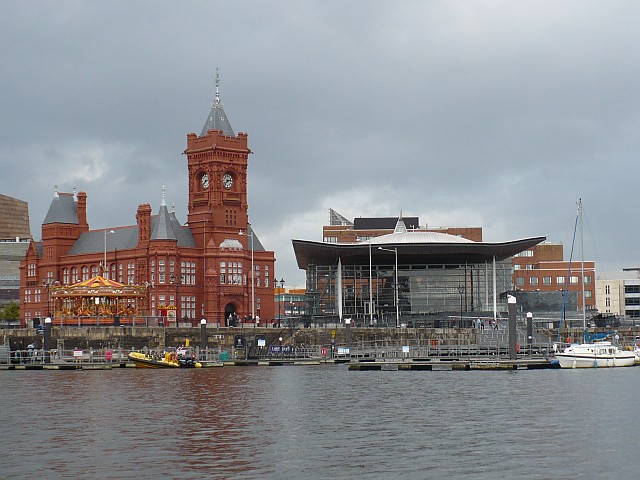

Notable buildings
The Pierhead Building was built in 1897. It was formerly the headquarters of the Bute Dock Company.


The Senedd is the National Assembly for Wales building which includes the debating chamber and committee rooms.

The Wales Millennium Centre is home to the Welsh National Opera.

Roald Dahl Plass (Welsh: Plas Roald Dahl) is a large open amphitheatre style plaza frequently used as a venue for carnivals and festivals all year round.

Roald Dahl Plass plaque

The St David's Hotel and Spa is a 5-star luxury hotel with commanding views of the Bay and Penarth. Built by Rocco Forte in 2000, the hotel was sold in 2007 to Principal-Haley hotels.

Norwegian Church is a rescued historic wooden church that was rebuilt in 1992

Techniquest is an educational science & discovery centre, which also includes a science theatre and planetarium.

Mermaid Quay comprises a mix of restaurants, bars, cafés, shops and services located on the waterfront.

The Red Dragon Centre is an indoor entertainment complex, opposite the Wales Millennium Centre. The complex features restaurants, cafés, a Hollywood Bowl with arcade amusements, an Odeon multiplex cinema, a casino and an on-site car park.

'The Tube' (Cardiff Bay Visitor Centre) dismantled in 2010

Harry Ramsden's, the Guiseley branch

The Coal Exchange(aka The Exchange Centre), a venue for staged events.

Cardiff Railway station, the unused building

Cardiff Queen Street railway station, south-end

Wetlands walkway in Cardiff Bay

Just a Sunday in Cardiff Bay By Martyn Joseph
Cardiff Bay played a major part in Cardiff’s development by being the means of exporting coal from the South Wales Valleys to the rest of the world, helping to power the Industrial Revolution of the 1790’s .
This rapidly increasing iron and coal trade was also the catalyst for the construction of a number of docks during the 1830’s. These included the Bute West Dock, which was the first dock to be opened by the 2nd Marquis of Bute in 1839 and its seaward entrance known as the Oval Basin, the Bute East Dock in 1855, Roath Basin in 1874, Roath Dock in 1887 and the Queen Alexandra Dock in 1907.
As Cardiff exports grew, so did its population; dockworkers and sailors from across the world settled in neighbourhoods close to the docks, and communities from at least 50 different nationalities, including Norwegian, Somali, Yemeni, Spanish, Italian, Caribbean and Irish helped create the unique multicultural character of the area , which became known as 'Tiger Bay'. This kaleidoscope of settlers helped to build the docks, worked aboard the ships and helped to service this industrial and maritime city.
After the Second World War, however, demand for coal slumped and international markets were lost as other countries developed their own steel industries, most of the industry closed down and became derelict.
By the early 1980’s Cardiff Bay had become a neglected wasteland of derelict docks and mudflats. Its population suffered from social exclusion and had above average levels of unemployment.
The Cardiff Bay Development Corporation was set up in April 1987 to regenerate the 1,100 hectares of old derelict docklands of Cardiff and Penarth. It was part of the British Government's 'Urban Development Programme' to regenerate particularly deprived and run-down areas of British inner cities.
The regeneration of Cardiff Bay is now widely regarded as one of the most successful regeneration projects in the United Kingdom. In 1999, the building of the Cardiff Bay Barrage is one of the most controversial building projects of the day but also one of the most successful. The Bay is supplied by two rivers (Taff and Ely) to form a 500-acre (2.0 km2) freshwater lake round the former dockland area south of the city centre. The Bay was formerly tidal, with access to the sea limited to a couple of hours each side of high water but now provides 24 hour access through three locks.
http://www.bbc.co.uk/wales/southeast/panoramics/pages/pierhead.shtml
http://www.cardiffbay.co.uk/index.php/
